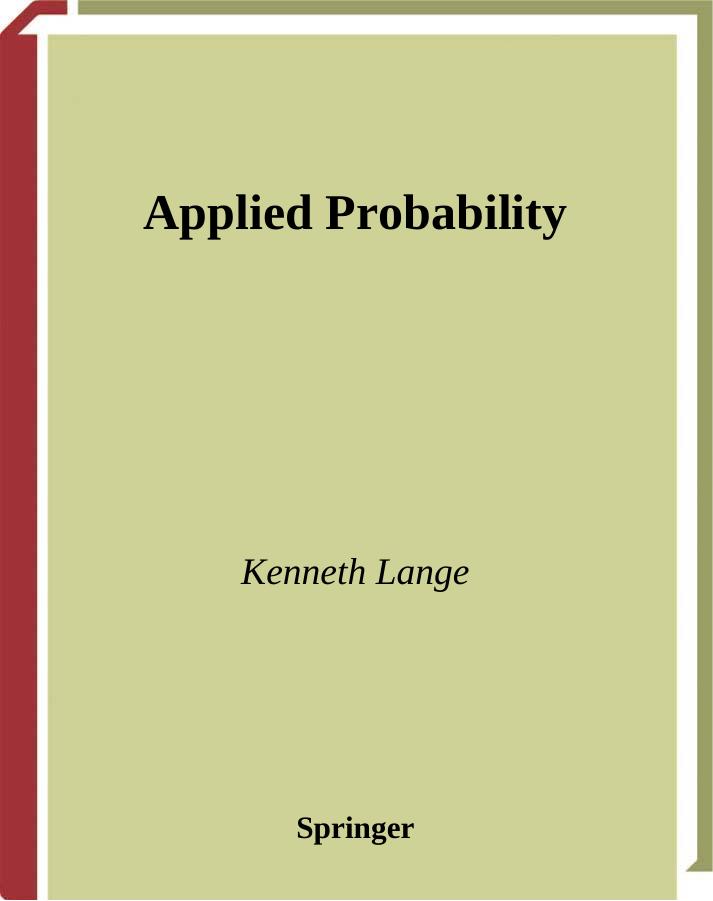Applied Probability by Kenneth Lange

Author:Kenneth Lange [Lange, Kenneth]
Language: eng
Format: epub, pdf
Published: 2011-02-20T03:05:49+00:00
=
Pr(ai) i=1
m
=
Pr(aij ). (9.10)
i=1 j
By construction, the founder genes assigned to different components do not impinge on one another. In other words, the set of founder genes consistent with G and M is drawn from the Cartesian product of the sets S1, . . . , Sm of legal allele vectors for the components C1, . . . , Cm, respectively. Applying the distributive rule to equation (9.10) consequently yields m
Prior(G)
=
Pr(Ci), (9.11)
G → G∩M
i=1
where
Pr(Ci) =
Pr(aij ).
ai∈Si j
As mentioned earlier, an allele vector set Si contains either all allele vectors or just two, one, or none. In the first case, Pr(Ci) =
a
Pr(ai) = 1,
i ∈Si
and in the remaining three cases, Pr(Ci) =
a
Pr(ai) contains only
i ∈Si
two, one, or no terms. Hence, calculation of Prior(G) reduces
G → G∩M
to easy component-by-component calculations.
Although likelihood calculation with non-codominant markers or incompletely penetrant traits can be handled similarly, two complications intrude.
First, we need a systematic method of generating the set Si of allele vectors for component Ci. Second, we must include penetrance values in the likelihood calculation, assuming that each person’s phenotypes at the various loci are independent conditional on his or her genotypes at the loci. Regarding the second complication, note that each component Ci carries with it a set Qi of phenotyped people through whom the founder genes pass.
Specifying an allele vector ai ∈ Si determines the genotype of each person k ∈ Qi. In computing Pr(Ci), we must multiply the product Pr(a
j
ij ) by
the penetrance of each k ∈ Qi at the current locus.
The allele vectors ai ∈ Si can be generated efficiently by a backtracking scheme [29]. This entails growing a compatible allele vector from partial vectors that are compatible. The idea can be illustrated by reference to component C2 = {A, C, E} of Figure 9.2 We start with the assignment (aA) = (1), which is consistent with the phenotypes in the pedigree, grow it to (aA, aC) = (1, 1), which is inconsistent, discard all vectors beginning with (aA, aC) = (1, 1), move on to (aA, aC) = (1, 2), which is consistent, grow this to (aA, aC, aE) = (1, 2, 1), which is consistent, discard each 9. Descent Graph Methods
181
of the next three vectors (aA, aC, aE) = (1, 2, 2), (aA, aC, aE) = (1, 2, 3), and (aA, aC, aE) = (1, 2, 4) as inconsistent, backtrack to the partial vector (aA, aC, ) = (1, 3), which is inconsistent, and so forth, until ultimately we identify the second compatible vector (aA, aC, aE) = (2, 1, 2) and reject all other allele vectors. The virtue of backtracking is that it eliminates large numbers of incompatible vectors without actually visiting each of them.
If penetrances are quantitative, so that every genotype is compatible with every phenotype, then Si expands to a Cartesian product having n|Ci| elements, where |Ci| is the number of founder genes in Ci and n is the number of alleles at the current locus. In this case, backtracking will successfully construct every allele vector
Download
This site does not store any files on its server. We only index and link to content provided by other sites. Please contact the content providers to delete copyright contents if any and email us, we'll remove relevant links or contents immediately.
Modelling of Convective Heat and Mass Transfer in Rotating Flows by Igor V. Shevchuk(6406)
Weapons of Math Destruction by Cathy O'Neil(6204)
Factfulness: Ten Reasons We're Wrong About the World – and Why Things Are Better Than You Think by Hans Rosling(4710)
A Mind For Numbers: How to Excel at Math and Science (Even If You Flunked Algebra) by Barbara Oakley(3248)
Descartes' Error by Antonio Damasio(3247)
Factfulness_Ten Reasons We're Wrong About the World_and Why Things Are Better Than You Think by Hans Rosling(3216)
TCP IP by Todd Lammle(3153)
Fooled by Randomness: The Hidden Role of Chance in Life and in the Markets by Nassim Nicholas Taleb(3076)
Applied Predictive Modeling by Max Kuhn & Kjell Johnson(3038)
The Tyranny of Metrics by Jerry Z. Muller(3025)
The Book of Numbers by Peter Bentley(2927)
The Great Unknown by Marcus du Sautoy(2661)
Once Upon an Algorithm by Martin Erwig(2619)
Easy Algebra Step-by-Step by Sandra Luna McCune(2602)
Lady Luck by Kristen Ashley(2551)
Police Exams Prep 2018-2019 by Kaplan Test Prep(2513)
Practical Guide To Principal Component Methods in R (Multivariate Analysis Book 2) by Alboukadel Kassambara(2512)
All Things Reconsidered by Bill Thompson III(2369)
Linear Time-Invariant Systems, Behaviors and Modules by Ulrich Oberst & Martin Scheicher & Ingrid Scheicher(2346)
